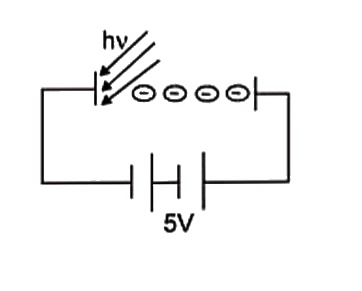Momentumof - ray proton of energy 3 eV in kg-m/s will be
The correct Answer is:C
To find the momentum of a gamma-ray proton with energy 3 eV, we can follow these steps:
Step 1: Convert Energy from eV to Joules
The energy given is in electron volts (eV). We need to convert this energy into joules (J) using the conversion factor:
1 eV = 1.6×10−19 J.
Given energy E=3 eV:
E=3×1.6×10−19 J=4.8×10−19 J
Step 2: Use the Formula for Momentum
The momentum P of a particle can be calculated using the formula:
P=√2mE
where m is the mass of the proton and E is the energy in joules.
Step 3: Substitute the Values
The mass of a proton m is approximately 9.1×10−31 kg. Now substituting the values into the momentum formula:
P=√2×(9.1×10−31 kg)×(4.8×10−19 J)
Step 4: Calculate the Value Inside the Square Root
First, calculate 2×9.1×10−31×4.8×10−19:
2×9.1×10−31×4.8×10−19=8.736×10−48 kg J
Step 5: Take the Square Root
Now, take the square root of the result:
P=√8.736×10−48≈2.95×10−24 kg m/s
Step 6: Round to Significant Figures
Rounding this to two significant figures gives:
P≈1.6×10−24 kg m/s
Final Answer
Thus, the momentum of the gamma-ray proton of energy 3 eV is approximately:
P≈1.6×10−24 kg m/s
The energy given is in electron volts (eV). We need to convert this energy into joules (J) using the conversion factor:
1 eV = 1.6×10−19 J.
E=3×1.6×10−19 J=4.8×10−19 J
The momentum P of a particle can be calculated using the formula:
P=√2mE
where m is the mass of the proton and E is the energy in joules.
The mass of a proton m is approximately 9.1×10−31 kg. Now substituting the values into the momentum formula:
P=√2×(9.1×10−31 kg)×(4.8×10−19 J)
First, calculate 2×9.1×10−31×4.8×10−19:
2×9.1×10−31×4.8×10−19=8.736×10−48 kg J
Now, take the square root of the result:
P=√8.736×10−48≈2.95×10−24 kg m/s
Rounding this to two significant figures gives:
P≈1.6×10−24 kg m/s
Thus, the momentum of the gamma-ray proton of energy 3 eV is approximately:
P≈1.6×10−24 kg m/s
Topper's Solved these Questions
- BOOK - RESONANCE ENGLISHCHAPTER - DAILY PRACTICE PROBLEMEXERCISE - DPP No.209videos
DAILY PRACTICE PROBLEM
- BOOK - RESONANCE ENGLISHCHAPTER - DAILY PRACTICE PROBLEMEXERCISE - DPP No.2120videos
DAILY PRACTICE PROBLEM
- BOOK - RESONANCE ENGLISHCHAPTER - DAILY PRACTICE PROBLEMEXERCISE - DPP No.189videos
DAILY PRACTICE PROBLEM
- BOOK - RESONANCE ENGLISHCHAPTER - CURRENT ELECTRICITYEXERCISE - High Level Problems (HIP)19videos
CURRENT ELECTRICITY
- BOOK - RESONANCE ENGLISHCHAPTER - ELECTRO MAGNETIC WAVESEXERCISE - Exercise 327videos
ELECTRO MAGNETIC WAVES
Similar Questions
The momentum of a photon of energy 1MeV "in"kgm/s will be
View SolutionFind frequency of a photon of energy 3.3 eV?
View SolutionAn electron-positron pair is produced when a γ-ray photon of energy 2.36MeV passes close to a heavy nucleus. Find the kinetic energy carried by each particle produced, as well as the total energy with each.
View SolutionA photon of energy 3.3 eV , find the momentum of photon is
View SolutionA gamma ray photon of energy 1896 MeV annihilates to produce a proton-antiproton pair. If the rest mass of each of the particles involved be 1.007276 a.m.u approximately, find how much K.E these will carry?
View SolutionIn a gamma decay process, the internal energy of a nucleus of mass M decreases, a gamma photon of energy E and linear momentum E/c is emitted and the nucleus recoils. Find the decrease in internal energy.
View SolutionA positron of 1MeV collides with an electron of 1MeV and gets annihilated and the reaction produces two γ−ray photons. If the effective mass of each photons is 0.0016amu, then the energy of each γ−ray photon is about-
View SolutionA monochromatic ray of photons of energy 5 eV are incident on cathode. Electrons reaching the anode have kinetic energyies varying from 6 eV to 8eV.Choose the correct option.
 View Solution
View SolutionIn an accelerator experiment on high energy collision of electrons with positrons, a certain events is interpreted as annihilation of an electron-positron pair of total energy 10.2 BeV into two γ-rays of equal energy. What is the wavelength associated with each γ-rays? (1BeV=109eV)
View SolutionA metal surface is illuminated by the protons of energy 5 eV and 2.5 eV respectively . The ratio of their wavelength is
View Solution

